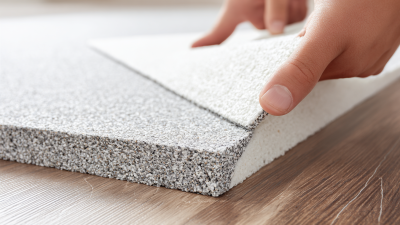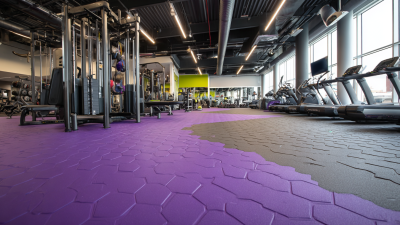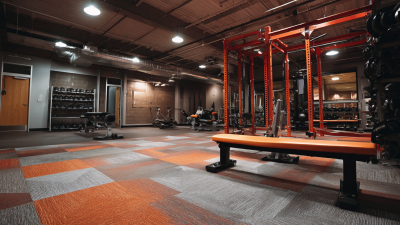In the ever-evolving realm of home fitness, the importance of creating an optimal workout environment cannot be overstated. As more individuals shift their exercise routines from gyms to their personal spaces, the demand for specialized equipment has surged. According to a report by Market Research Future, the global home fitness equipment market is expected to reach over $12 billion by 2025, highlighting the increasing investment in creating effective home workout areas. A key component often overlooked in this setup is the Gym Floor Mat, which serves not only to protect your floors but also to enhance safety and performance during various exercises.
Choosing the right Gym Floor Mat can significantly impact your workout experience. With the rise in popularity of diverse fitness routines, from yoga and Pilates to weightlifting and high-intensity interval training (HIIT), selecting a mat that offers the right level of cushioning, stability, and grip is crucial. Research from the International Health, Racquet & Sportsclub Association indicates that more than 60% of fitness enthusiasts now prefer working out at home. This trend has underscored the need for effective home solutions, positioning the Gym Floor Mat as a vital investment for anyone serious about maximizing their fitness regime and maintaining an injury-free environment. Understanding the unique features and benefits of different mats will empower you to make an informed choice that complements your workout style and space.

When it comes to selecting the ideal gym floor mat for your home fitness space, understanding the various materials and features available is crucial. Rubber mats are one of the most popular choices due to their durability and shock-absorbent properties. They offer excellent traction, making them suitable for weightlifting and high-impact workouts. Additionally, rubber mats are resistant to water and sweat, which helps maintain hygiene and prolongs the life of the mat.
Foam mats, on the other hand, provide a softer surface that is ideal for yoga, stretching, and floor exercises. They come in various thicknesses, offering varying levels of cushioning to suit different activities. While foam mats are lightweight and easy to carry, they may not offer the same level of protection against heavy equipment as rubber mats. For those seeking versatility, interlocking tile mats made from either foam or rubber allow for customizable spaces, adapting to different workout needs while ensuring easy installation and maintenance.
When selecting a gym floor mat for your home fitness space, the right size is crucial to ensure both functionality and comfort. First, consider the available space in your room. Measure the area where you plan to place the mat, accounting for any furniture or equipment that may occupy the floor. A mat that is too small may not provide the necessary coverage for your workouts, while one that is overly large could limit your movement and feel cramped.
In addition to the measurements of your space, think about the type of exercises you’ll be doing. Different activities, such as yoga, weightlifting, or high-intensity training, may require varying amounts of space. For instance, a yoga session may need a larger, uninterrupted area to allow for full-range movements, whereas lifting weights might be more focused on a smaller designated zone. By aligning the mat size with your workout routine, you can create a more effective and enjoyable fitness environment.
| Mat Type | Size (ft) | Thickness (in) | Material | Price ($) |
|---|---|---|---|---|
| Foam Mat | 6 x 4 | 1/2 | EVA Foam | 30 |
| Rubber Mat | 6 x 4 | 1 | Natural Rubber | 50 |
| PVC Mat | 5 x 3 | 1/4 | PVC | 25 |
| Jigsaw Mat | 3 x 3 | 3/8 | EVA Foam | 40 |
| Carpet Mat | 5 x 4 | 1/2 | Synthetic Fiber | 35 |
When setting up a home fitness space, the benefits of incorporating a high-quality gym floor mat cannot be overstated. According to a report by the International Health, Racquet & Sportsclub Association (IHRSA), 60% of fitness enthusiasts agree that having an appropriate exercise surface significantly enhances their workout experience. A gym mat not only provides comfort underfoot, reducing strain on joints during exercises, but it also ensures a safer workout environment by minimizing the risk of slips and falls on hard surfaces.
In addition to safety and comfort, gym floor mats play a crucial role in protecting your flooring. A study by the National Institute of Health indicated that equipment-induced damage to flooring increases the maintenance costs in home gyms by up to 30%. By using a durable mat, you can significantly extend the lifespan of your flooring while keeping your workout area clean and hygienic. Furthermore, mats equipped with anti-microbial properties can reduce the spread of bacteria, enhancing the overall cleanliness of your fitness space and promoting a healthier lifestyle.
Maintaining your gym floor mat is crucial not only for its longevity but also for ensuring a safe and hygienic workout environment. According to a report by the International Health, Racquet & Sportsclub Association (IHRSA), over 60% of gym-goers prioritize cleanliness when selecting a fitness facility. This statistic underscores the importance of keeping your home gym space immaculate, as the lack of maintenance can lead to bacteria and allergens accumulating on the mat, which may result in health issues.
To effectively maintain your gym floor mat, consider using a gentle cleaner specifically designed for gym surfaces. Regularly vacuuming or sweeping your mat will help remove dust and debris, which can otherwise scratch the surface and reduce its lifespan. The National Institute of Health (NIH) suggests cleaning your mat at least once a week, or more frequently if it's used for high-intensity workouts. Additionally, allowing your mat to dry completely after cleaning is essential to prevent mold and mildew growth. By adhering to these best practices, you can ensure that your gym floor mat remains in optimal condition, allowing for a safe and enjoyable workout experience.
When considering the purchase of a gym floor mat, budgeting is crucial to ensure you get a quality product that meets your home fitness needs. Research indicates that the average price range for a good quality exercise mat varies between $30 and $120, depending on materials, thickness, and durability. Investing in a higher-end mat can enhance stability and comfort, especially when performing high-impact exercises or yoga. According to industry reports, selecting a mat that combines both functionality and affordability can lead to improved workout consistency, as participants are less likely to skip sessions due to discomfort.
Moreover, for those building a home gym on a budget, it’s essential to look for mats that offer multi-functionality. Some mats are specifically designed for various exercises—yoga, Pilates, or high-intensity training—ensuring you maximize your investment. Affordable options are available, with some as low as $29.99, which can complement other budget-friendly fitness equipment. This strategic approach not only enhances your workout experience but also allows you to allocate funds to other essential gym accessories, creating a well-rounded fitness space without breaking the bank.






